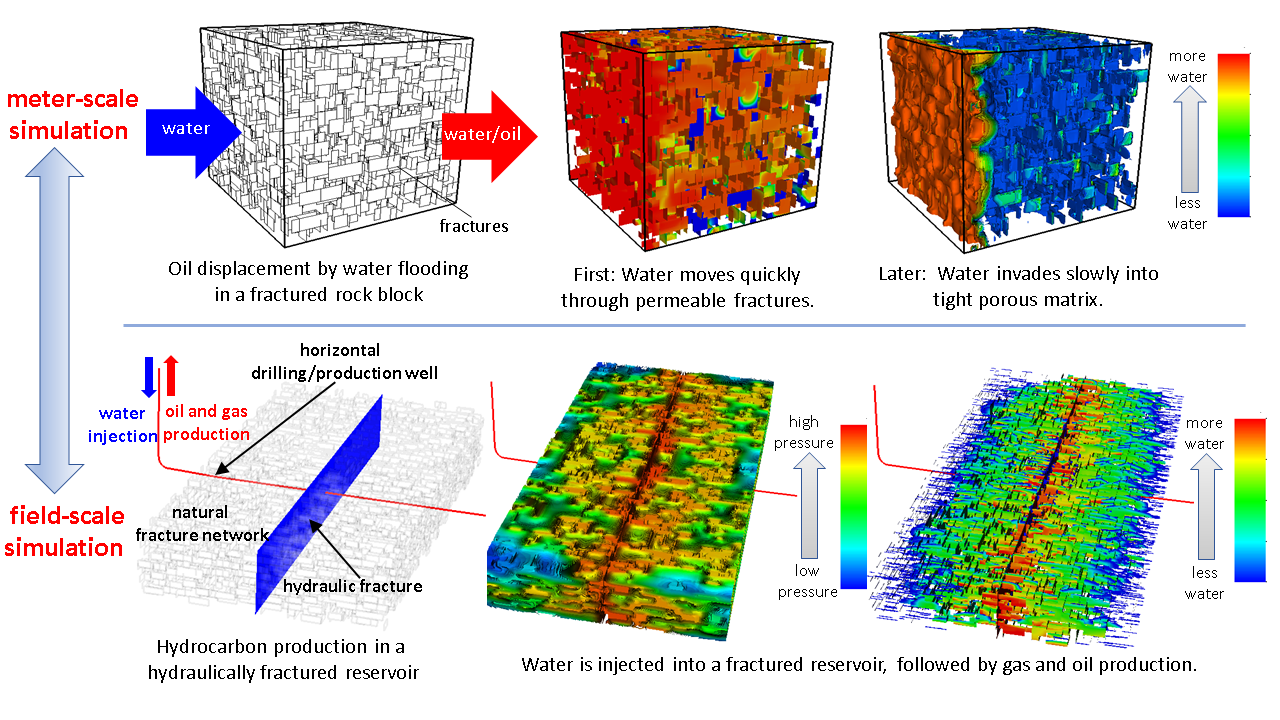Yue Hao | 16-ERD-014
Overview
Production of gas and oil from hydraulically fractured shale reservoirs relies on the immediate release of hydrocarbon fluids intercepted by the fractures and the transient migration of hydrocarbon fluids from the matrix rock to the fractures. Accurate modeling of the matrix–fracture flow and transfer processes is critical to understanding the fundamental physical mechanisms driving hydrocarbon fluid flow and unconventional hydrocarbon production and may provide the key to sustainable productivity. During this project, we developed a high-fidelity discrete-fracture-flow modeling framework with improved physics to simulate flow and transport among fractures and surrounding shale or low-permeability rocks. The discrete-fracture model (DFM) can explicitly account for individual fractures and surrounding rocks, thus providing a more precise representation of fluid flow and transport at the fracture–matrix interface. Key components of the project included (1) creating a robust discrete-fracture-flow model in GEOS (the massively parallel multiphysics simulation code developed at Lawrence Livermore National Laboratory); (2) integrating the physical models of relevant multiphase flow phenomena into the DFM framework; (3) developing an improved understanding of unconventional flow and transport behaviors in shale, from molecular to continuum scales; and (4) applying the DFM to unconventional hydrocarbon recovery and other subsurface flow applications. We have developed a first-of-its-kind discrete-fracture-flow modeling paradigm for operational-scale applications. This has led to improved modeling capabilities for the interpretation of shale-gas and oil-recovery operations and the creation of optimized solutions for hydraulic-fracturing operations, which promise to benefit many other energy and national security applications.
Background and Research Objectives
Flow and transport processes in fractured rocks are of great importance for a wide range of subsurface applications, such as CO 2 sequestration, enhanced geothermal exploration, and the geological storage of nuclear waste. An important example of complex matrix–fracture flow is related to hydrocarbon production from hydraulically fractured shale reservoirs. Because shale gas or oil is typically found in extremely tight formations, commercial hydrocarbon production is increasingly enabled through hydraulic fracturing techniques that generate extensive fracture networks in the rock. While various physical processes (e.g., proppant compaction) may influence reservoir productivity, multiphase flow behaviors of hydrocarbon and injection fluids at the interface between low-permeability host rock and stimulated fractures play an important role in controlling both hydrocarbon production and fracturing-fluid recovery.
The modeling of hydrocarbon fluid flow and transfer processes in fractured-shale reservoirs is critical in the planning and assessment of shale-reservoir production and the evaluation of hydraulic-fracture performance. Nevertheless, current reservoir simulators, which typically employ continuum conceptualizations for predicting the hydrocarbon production of fractured-shale reservoirs, suffer from empiricism, limitations in their fundamental conceptualization, and an inability to accurately represent fracture–matrix interactions in fractured formations. Specifically, fracture–matrix communication in the continuum models cannot viably describe localized or highly transient conditions in individual fracture and matrix blocks, especially in low-permeability rocks.
During this project, we developed a discrete-fracture-flow model with an explicit representation of both individual fractures and their surrounding rock matrix, thereby providing a more accurate description of flow and transport processes in fractured shale or low-permeability reservoirs.
Impact on Mission
This project provides a first-of-a-kind demonstration of discrete-fracture modeling of multiphase flow in fractured, low-permeability rocks and its coupling with hydro-fracture models for field-scale applications. The principal benefits lie in extending the new fractured-rock modeling paradigm into a more operational design setting, including (1) improving the interpretive capabilities of field-scale observations, (2) creating optimized solutions for well placement and fracturing implementation activities, (3) upgrading some legacy reservoir models for prediction and design of shale gas and oil recovery operations, (4) coupling with related physical models (e.g., geochemical effects), and (5) integration with uncertainty quantification techniques. In addition to unconventional hydrocarbon recovery, the new modeling capability enables Lawrence Livermore to play a leading role in subsurface transport simulation for other energy-, national security-, and environment- related programs such as enhanced geothermal systems, geological CO 2 storage, and subsurface radionuclide or contaminant migration. For example, our modeling technique has been applied to support subsurface transport modeling work related to the detection and monitoring of underground explosions. The successful application of the coarse-grained molecular dynamics Martini approach to modeling shale molecular structures (Martini was originally a model of a force field designed for biology simulations) has opened a new area of research with great impact upon our understanding of production in shales.
Conclusion
This research achieved a major advance in the simulation of flow and transport in fractured shale or low-permeability reservoirs, affording improved understanding of the effects of fracture–matrix interactions on multiphase flow processes that influence sustainable shale gas and oil recovery and supporting the interpretation of field observations that are poorly explained by current conventional reservoir simulators. It will be of immediate value to several externally funded projects in unconventional hydrocarbon recovery and national security-related applications. We will continue to seek external funding from partners in the petroleum industry and the DOE Office of Oil and Gas.
Publications and Presentations
Fu , P ., et al. 2017 . " The Influence of Hydraulic Fracturing on Carbon Storage Performance." J. Geophys. Res.:Solid Earth 122 : 9931–9949. LLNL-JRNL-738072.
Hao, Y., et al. 2016. "The Effect of Fracture-Matrix Interactions on Multiphase Flow in Fractured Reservoirs: Development of a Discrete Fracture Model." The XXI International Conference on Computational Methods in Water Resources, Toronto, Canada, June 2016. LLNL-ABS-679532.
——— . 2016. "Discrete Fracture Modeling of Multiphase Flow and Hydrocarbon Production in Fractured Shale or Low Permeability Reservoirs." 2016 American Geophysical Union Fall Meeting, San Francisco, CA, December 2016. LLNL-ABS-699899.
——— . 2017. "Numerical Evaluation of Multiphase Flow Processes and Their Effects on Hydrocarbon Production in Hydraulically Fractured Reservoirs." 9th International Conference on Porous Media and Annual Meeting, Rotterdam, Netherlands, May 2017. LLNL-ABS-709521.
——— . 2018. "A High-Fidelity Discrete Fracture Model of Fracture-Matrix Flow in Fractured Shale or Low-Permeability Reservoirs." The XXII International Conference on Computational Methods in Water Resources, CMWR 2018, Saint-Malo, France, June 2018. LLNL-ABS-741942.






